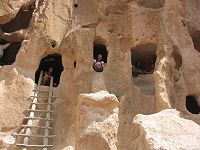Bandelier National Monument’s 90th birthday is a triumph of history, preservation.
Bandelier National Monument once home to the Anasazi
Cecilia Shields walks in the footsteps of her ancestors.
An interpretive park ranger at Bandelier National Monument for the past seven years, she sees and feels things that casual visitors miss.
Walking the Main Loop Trail, Shields, who is Picuris, Ohkay Owingeh and Mescalero Apache, pointed to the remains of walls that at one time were part of the teeming Tyuonyi Pueblo.
 A little farther down the trail she motioned at a petroglyph carved high into the south wall of Frijoles Canyon. In contrast to the north wall, which has a gentler slope and thicker vegetation, the south side is sheer and laced with more than 1,000 recorded cavates, small caves carved into the volcanic tuff. They were used by the ancient residents for storage or living.
A little farther down the trail she motioned at a petroglyph carved high into the south wall of Frijoles Canyon. In contrast to the north wall, which has a gentler slope and thicker vegetation, the south side is sheer and laced with more than 1,000 recorded cavates, small caves carved into the volcanic tuff. They were used by the ancient residents for storage or living.
“I like that petroglyph a lot,” she said of a sun symbol with radiating rays. “So many people come to Bandelier, and they’re caught up in hurrying through to get to the next destination that they don’t see the subtleties and evidence of human habitation here beyond the walls, which they refer to as ruins. They’re not ruins. Bandelier is still alive.
“In the spring, the flowers still bloom and birds still come to sing with the spirits of the ancestral people. And when the ancient ones are thirsty, the rain clouds still bring them water and the creek still flows.”
It is that reverence for the past and an ability to make long-vanished people and culturesrelevant to today that originally drew Adolph Bandelier to the area named in his honor.
100th anniversary of the 1906 Antiquities Act
This year marks the 100th anniversary of the 1906 Antiquities Act, which protects historic and prehistoric sites and artifacts on federal lands and allows the president of the United States to declare public lands as national monuments.
It is also the 90th anniversary of President Woodrow Wilson’s declaration of Bandelier as a national monument. In recognition of those milestones, the National Park Service will host a series of events throughout the year.
Adolph Bandelier, a self-taught archaeologist from Illinois, went to the New Mexico Territory in 1880. He lived among the Cochiti people, who first showed him Pajarito Plateau and Frijoles Canyon, site of the modern-day monument. He declared it “the grandest thing I ever saw.”
The pueblo’s ancestral people, sometimes referred to as Anasazi (“old ones”), moved to the area about 1,100 years ago. Holes in the volcanic tuff of the south wall, deposited by volcanic eruptions 1.6 million and 1.2 million years ago, were enlarged to create living and storage spaces.
At its peak, about 700 people lived in Frijoles Canyon and nearly 20,000 in the overall Pajarito Plateau, Shields said. About A.D. 1550, the ancestral people of Pajarito Plateau and those of what is now Bandelier left the area and relocated to other places along the Rio Grande.
They settled in what are now San Ildefonso, Santa Clara, San Felipe, Santo Domingo and Cochiti pueblos.
It is believed that drought and population growth beyond what the land could sustain led to the relocation, Shields said.
Bandelier, the site, had been vacated, but it hadn’t vanished.
Credit the Great Depression for making Bandelier National Monument more accessible and user- friendly.
A rustic lodge, the Ranch of the Ten Elders, had been built in the canyon in 1907 and later operated by Evelyn and George Frey. They and their guests toted all their goods into the canyon on horseback over a half-mile of switchbacks still known as Frey Trail.
From 1933 through 1941, the Depression-era Civilian Conservation Corps built 32 structures at Bandelier, including a fire lookout tower, the main road into the park and a new Pueblo Revival-style lodge, now the visitor center and administrative buildings.
RELATED LINKS:
Petroglyph pictures taken in Bandolier National Monument
ABOUT THE AUTHOR:
Rick Nathanson writes for the Albuquerque Journal. This article first appeared in the Rocky Mountain News

